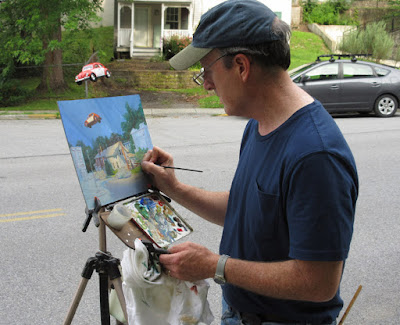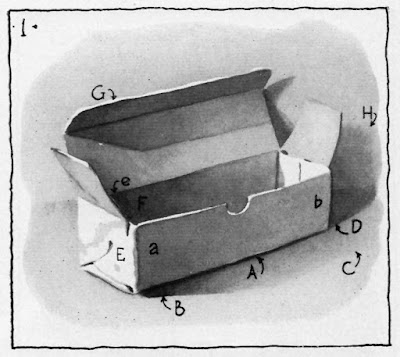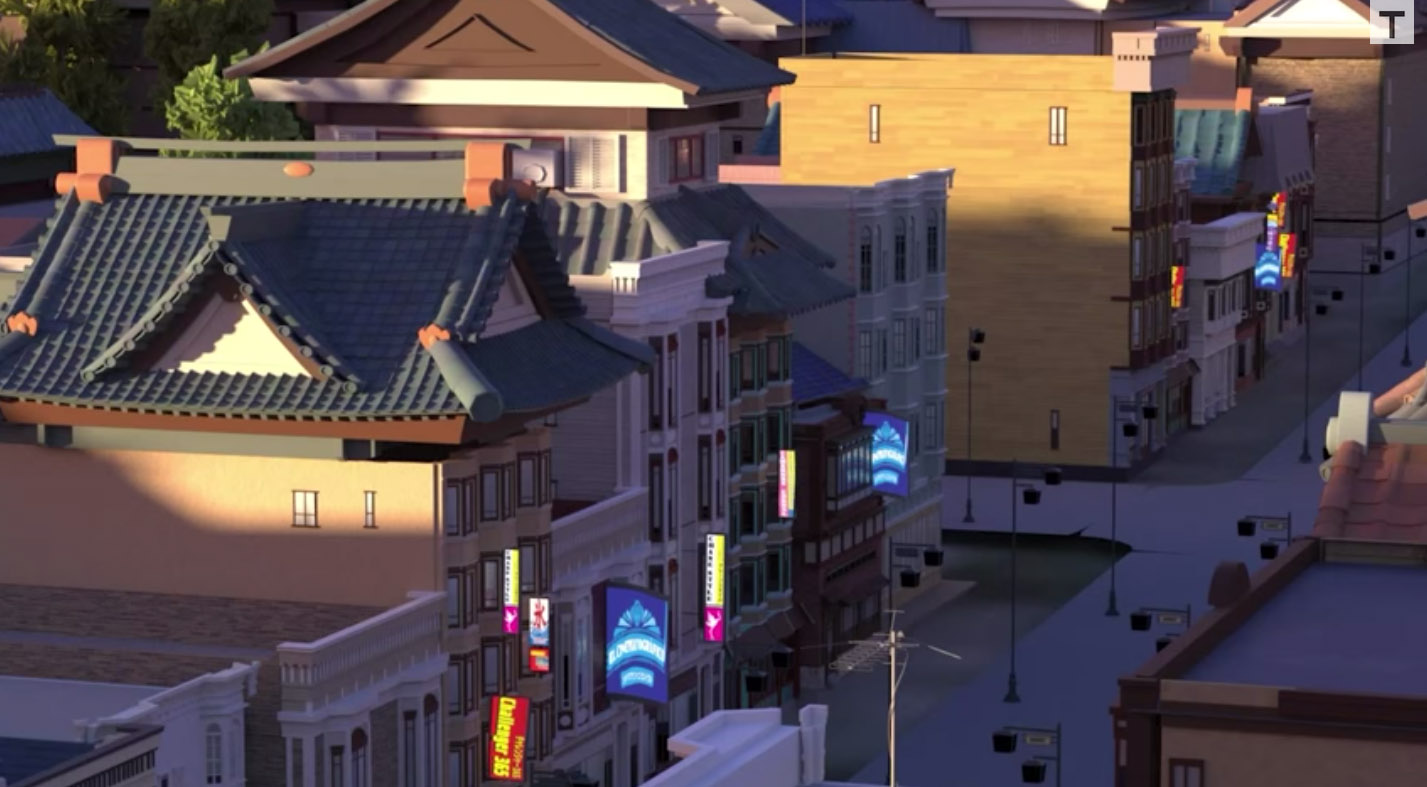Lisa Jones has released a new range of gift wrap which includes this fun animal design. Lisa describes the new collection as 100% cheerful and 100% recycled. Sold in sheets of two they are locally printed Lisa's hometown of Lewes in East Sussex and use vegetable based inks. Scroll down to see more, including the clever 'Apartment' wrapping paper. along with some more of Lisa Jones' designs on
Viewing: Blog Posts Tagged with: Simple Things, Most Recent at Top [Help]
Results 1 - 25 of 70
Blog: print & pattern (Login to Add to MyJacketFlap)
JacketFlap tags: CARDS, Lighting, GIFT WRAP, Add a tag
Blog: Gurney Journey (Login to Add to MyJacketFlap)
JacketFlap tags: Portraits, Lighting, Add a tag
Sir John Leighton, the Director-General of the Scottish National Gallery, served as both painter's model and keynote speaker at the Portrait Society's annual conference yesterday.
 |
| Sir John Leighton by James Gurney, black and white gouache, 3 x 3 inches |
Mr. Neal lit him with a two-source lighting scheme inspired by Anders Zorn (Swedish, 1860-1920). The lighting scheme produces a shadow core in the center of the form and often puts the eyes in shadow.
In the case of this Zorn, those dark accents in the face float in the middle of a sea of creamy white, the reverse of the usual tonal scheme of a portrait.
Watch a 15-second video clip of my sketch in context on my Instagram, Twitter, or Facebook page.
Split lighting
Blog: print & pattern (Login to Add to MyJacketFlap)
JacketFlap tags: WALL ART, KIDS DESIGN, CARDS, Lighting, Add a tag
These cute design are all from the Dutch based 'A Little Lovely Company'. The business was founded in 2013 by designers Judith de Ruijter & Nikki Hateley, and it has become known for it's fashionable lightbox lamps which use typography to create messages, names and slogans. Their philosophy is to design products that can make life a little more lovely and their current range includes toys,
Blog: Gurney Journey (Login to Add to MyJacketFlap)
JacketFlap tags: Color, Lighting, Visual Perception, Add a tag
Whether you call it lens flare (what happens in a camera when you look at the sun) or color corona (a similar phenomenon that happens in your eye), it's a powerful effect that's popular in photography and video these days, but it's also something that has fascinated painters for a long time.
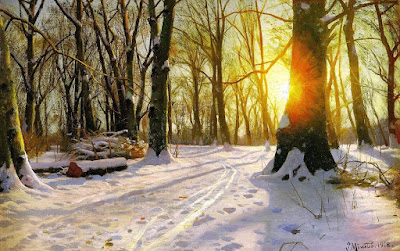 |
| Peder Mønsted, A Winter's Day |
The effect comes from light scattered by water vapor and dust in the air between you and the sun. The light is further scattered by your eyelashes when you squint, and then by the aqueous humor and vitreous fluid of the eye. The effect is best observed when you glimpse a setting sun through trees or when you see a streetlight at night.
Try squinting hard at a streetlight and tilting your head to see how the rays tilt with you. Also, try walking through the forest where the sun is mostly blocked by branches and glance up toward the sun as you walk to see how the corona comes and goes.
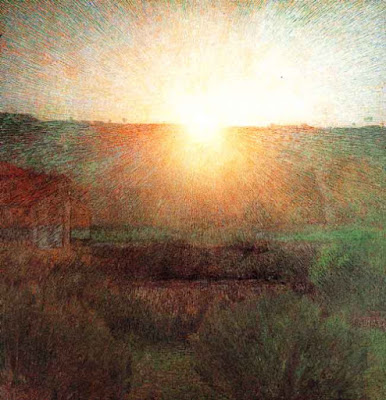 |
| Giuseppe Pellizza (Italian, 1868-1907) Volpedo, The Sun, 1904 |
Lens flare is easy for digital artists to add, and a little harder for physical painters, depending on the technique. As a photographic effect, it has origins in camera optics. Its artistic use—and overuse—in film, television, and photography is well explained in this Vox video (link to YouTube). Thanks, Dan.
--------
Related GurneyJourney posts:
Color Corona
How to Get a Feeling of Misty Light
Practical Lights
Light Spill
More of this kind of stuff in my book Color and Light: A Guide for the Realist Painter
Blog: Gurney Journey (Login to Add to MyJacketFlap)
JacketFlap tags: Plein Air Painting, Lighting, Add a tag
 |
| Micronesia foliage from U.C. Berkeley |
 |
| James Perry Wilson, Summery Showers |
Blog: Gurney Journey (Login to Add to MyJacketFlap)
JacketFlap tags: Lighting, Add a tag
I wrote an article appearing in the current (November) issue of ImagineFX magazine about painting bizarre lighting on location. The article opens: "Who says you have to copy mundane reality when you're outside plein-air painting?"
I'll share more about the making of this painting on the blog in November. It will be one of the subjects of an upcoming tutorial video called "Fantasy in the Wild."
Blog: print & pattern (Login to Add to MyJacketFlap)
JacketFlap tags: Lighting, Add a tag
This week we are looking at an 80s-esque designs inspired by the Memphis Milano design movement. We begin today with these bold graphic designs from Davide G.Aquini. Called 'The Macarons' they are wooden table lamps with patterned lampshades produced by Progetti in Luce. Davide is a freelance designer and lecturer from Venice who studied Graphic Design but now works on furniture and lighting
Blog: print & pattern (Login to Add to MyJacketFlap)
JacketFlap tags: Lighting, TEXTILES, Add a tag
Alison Ellerbrook of 'Hunky Dory Home' has just released her first design collection called 'Retro Flowers'. This is the first time Alison has produced her own fabric rather than using designer prints to create lampshades and cushions. The designs reflect her love of playful, vintage style and bright colour and says they were created to ooze nostalgia! The lamps retail for £75.00 including
Blog: Gurney Journey (Login to Add to MyJacketFlap)
JacketFlap tags: Lighting, Add a tag
In this study, Guptill says, "interesting reflected lights have crept into the shadow tone at (A) Note how the inside corner (e) has been sacrificed to express depth and detachment."
After doing a few of these studies, it will be much easier to paint a more complex or dynamic subject, such as a building, a figure, a portrait, or an animal.
----
From Arthur Guptill's book Color in Sketching and Rendering.
If you like this post, you'll also like:
Arthur Guptill Renders a Window
Guptill's Right and Wrong Methods
Sepia Wash Drawing
Cast Shadow in the Foreground
Blog: Gurney Journey (Login to Add to MyJacketFlap)
JacketFlap tags: Lighting, Add a tag
| Picture by John VanHouten |
"Hey James,
I know you say on your website that you don't give personal art advice but this question is about light. Specifically, the phrase about the lightest darks being darker than the darkest lights. I'm working on a painting and I'm not sure if darkening the shadow area of the skeleton will make it lose its local color of yellowish off-white, because it would be darker than the lightest part of the dark cloak. Is the phrase about darkest lights and lightest darks just applied to only one object at a time or is it applied to a whole image like the skeleton AND the robe? What do you think?
Hi, John,
There are kind of two different principles at work here, and those principles sound similar, so they can be a little confusing.
1. One is that the darkest values on the lit side of a given object are almost always lighter than the lightest values of the same object in shadow. This is assuming that the object is of a fairly constant local color and a fairly matte surface, such as a skull, fabric, or skin. It would not apply to something patterned, glossy, or highly reflective. It's also assuming we're talking about sunlight or any strong light source with normal surfaces bouncing the light back into the shadow. Given those constraints, this one is nearly always true. You seem to be adhering to the principle in your picture.
So as you guessed, the first rule applies to one object at a time and the second rule applies to the whole picture. These principles come up because students tend to underestimate the depth of shadows. They also tend to introduce too much tonal variation within the lights and too much tonal variation in the shadows. This happens because our visual brains use context cues to override the luminance information that our retinas actually receive.
You also mentioned a concern about maintaining the appearance of the local color of the skull as it moves from light into shadow. A white object can move through a wild range of colors as it absorbs different influences around it. I'm guessing that reflected light from the yellow tassel would spread a vertical glowing band of warm light—thought too light in value—to the area of the shadowed skull just to the left of the tassel.
One more thing: Can you get that student on a better meal plan?
----
Previously: Black is Light, White is Dark
More in my book: Color and Light: A Guide for the Realist Painter
Blog: Gurney Journey (Login to Add to MyJacketFlap)
JacketFlap tags: Color, Journey to Chandara, Lighting, Imaginative Realism, Color and Light Book, Add a tag
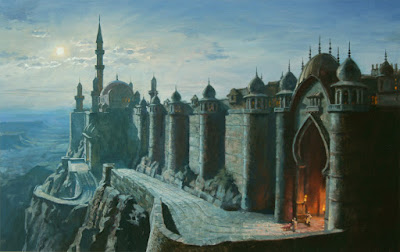 |
| Khasra by Moonlight by James Gurney, 12 x 18 inches, oil on board |
I quickly discovered that I had to move the actual lighting position quite far to the left, much farther to the left than the position of the moon in the painting.
My Public Facebook page
GurneyJourney on Pinterest
JamesGurney Art on Instagram
@GurneyJourney on Twitter
Blog: print & pattern (Login to Add to MyJacketFlap)
JacketFlap tags: Lighting, TEXTILES, TEA TOWELS, Add a tag
Jessica Hayman established Rose & Clara Designs in 2013. Previously working as a lawyer she decided to return to her first love : design. Jessica creates her cheerful patterns and illustrations, which are based on hand drawn images, from her studio in London. Her prints are showcased on her range of British-made homewares, gifts and stationery, which are available from selected retail
Blog: print & pattern (Login to Add to MyJacketFlap)
JacketFlap tags: Lighting, MUGS, TEXTILES, Add a tag
Martha and Hepsie are two sisters who design and sell illustrated homewares, stationery and gifts with pops of colour and character that are all made in Britain. Under the label Martha & Hepsie Ltd their current product portfolio includes lampshades, cushions, ceramics, prints, notebooks, gift tape and greetings cards. Martha graduated with a BA (Hons) in Textile Design and Hepsie in Fashion
Blog: print & pattern (Login to Add to MyJacketFlap)
JacketFlap tags: TOP DRAWER, BEDLINEN, Lighting, WALLPAPER, Add a tag
The 'Home' show was co-located with Top Drawer this week at London Olympia. One of the highlights was the launch of Mini Moderns three new Hinterland prints. The fourth wallpaper in the range was 'Gulls' which was launched alongside 'Pluto' and 'Equinox' to complete the collection which was shown in it's entirety for the first time. See more about all their products including bedding, paint
Blog: Gurney Journey (Login to Add to MyJacketFlap)
JacketFlap tags: Book reviews, Lighting, Add a tag
Scott Robertson recently released his new book How to Render: The Fundamentals of Light, Shadow, and Reflectivity
It's a followup to his previous book How to Draw, which I reviewed last year. Once you know how to draw the outlines of an object in perspective, the next thing is how to to use light and shade to bring out the form, and how various surfaces will look in different conditions. That's what this book concentrates on.
Scott has plenty of experience as a teacher. He has taught at art schools, seminars, and workshops, and has produced a lot of DVDs for Gnomon. He also shares regular videos on his YouTube channel.
He brings all that experience to his organization of the book. The book is divided into two main sections: 1. The physics and the perspective of light and shadow, and 2. The physics of reflectivity.

The book opens with a presentation of drawing tools, and then dives into a discussion of the kinds of light and the elements of form. He uses as examples both ideal geometric forms and photos of real objects (such as sculpture and architecture).
In one section of the book, Scott guides the reader through various practical systems for constructing shadows in perspective using geometric forms. That section feels a bit like a math textbook, but that's the only way to learn it, especially if you're creating imaginary forms.
The second half of the book analyzes reflective surfaces and their specific properties: including the Fresnel effect, reflection flipping, reflection pools, reflections over graphics, and cast shadows on reflective surfaces. He also goes through a catalog of examples of specific materials, such as glass, plastic, chrome, gold, wood, leather, and cloth, as well as examples of photographic effects such as motion blur and depth of field.

Scott does some rendering demos using both digital and physical techniques, so they will be of universal value from a technical perspective. Although there is some limited coverage of organic, natural forms (such as portraits, plants, animals, and landscapes) and passing references to atmospheric effects, the chief focus of the book is on transportation design—such things as cars, airplanes and robots.
The book was created by Robertson's own publishing company Design Studio Press. It is large (9x11 inches), thick (272 pages), and printed on heavy opaque paper. The book also provides the reader with special access to dozens of supplementary online videos.
How to Render: The Fundamentals of Light, Shadow, and Reflectivity is a rigorous book that covers the subject comprehensively and authoritatively, and it should become a useful textbook for many years to come.
Blog: Gurney Journey (Login to Add to MyJacketFlap)
JacketFlap tags: Color, Lighting, Add a tag
 |
| LA Streetlights, before (left half) and after (right half) c/o LA Curbed and LA Bureau of Street Lighting |
They're making the change because the new LED lights run far more efficiently and last longer. But an additional consequence of the change is a different visual appearance to nightscapes, which affects nocturnal on-the-spot painters, filmmakers, or anyone who is sensitive to the qualities of light.
 |
| LA Streetlights, before (left half) and after (right half) c/o LA Curbed |
That older sodium vapor light is almost a monochromatic orange, as you can see from the solitary spike on the spectral power distribution chart at the lower left, which charts wavelength against output.
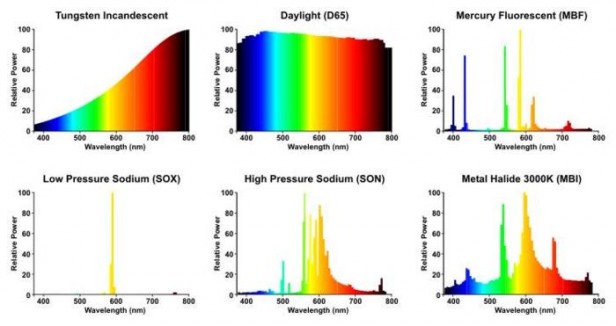 |
| Spectral Power Distribution of various light sources c/o NoFilmSchool |
Natural daylight (center top) is the standard, with all the colors well represented.
 |
| Spectral Power Distribution for a Philips Lumileds LED |
More in my book about light and color for painters:
Color and Light: A Guide for the Realist Painter
Read more online:
No Film School: "Why Hollywood Will Never Look the Same Again"
LA's New LED Streetlights Will Change the Way Movies Look
Thanks, Angela
Blog: Gurney Journey (Login to Add to MyJacketFlap)
JacketFlap tags: Color, Watercolor Painting, Lighting, Add a tag
Blog: Gurney Journey (Login to Add to MyJacketFlap)
JacketFlap tags: Animation, Color, Lighting, Computer Graphics, Add a tag
The new animated film Big Hero 6 uses a new rendering system developed at Disney Animation Studios that simulates the effect of light on surfaces with much more subtlety and nuance than in previous CGI animated films.
In this video, Norm from Tested interviews Mr. Hendrickson about the techniques and challenges. (link to video).
Book: The Art of Big Hero 6
Ray tracing on Wikipedia
All images ©Disney 2014
Speaking of animation, I'll be a speaker at CTN Animation Expo at Burbank in less than two weeks, giving presentations about Color and Light and Imaginative Realism. Hope to meet you there.
Blog: Gurney Journey (Login to Add to MyJacketFlap)
JacketFlap tags: Academic Painters, Lighting, Add a tag
Blog reader Haden asks: "Everyone is familiar with the rule - the darkest light in the light has to be lighter than the lightest dark in the shadow. Keep the light and dark tonal ranges separate to show realistic form. But I've seen a lot of paintings when an object with a dark local value is pretty dark even though it's in the light."
 |
Joaquín Sorolla (1863-1923), "Sad Inheritance" |
Haden continues: "Take for instance the Sorolla (painting above). The coat and the kids flesh are very different local values. According to that rule, the coat in the light should be lighter than the shadows on the kids (reflected light would be lightening their shadow sides a touch). But still the coat in the light is almost black, shouldn't it be a mid-grey?"
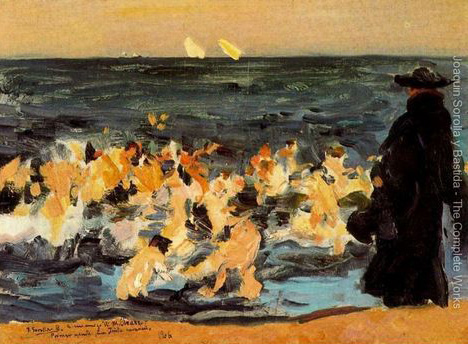 |
| Sorolla's first sketch for "Sad Inheritance" |
Blog: print & pattern (Login to Add to MyJacketFlap)
JacketFlap tags: Lighting, Add a tag
Atomic Doris creator Katie Ramsden has been researching, developing and perfecting the process of her unique silhouette lampshades for over two years in her Northampton based studio. Each shade is composed of cut vinyl designs hidden underneath FSC accredited lining paper. The lampshades are plain when off but patterned when on due to their unique design process. With a range of prints, colours
Blog: Gurney Journey (Login to Add to MyJacketFlap)
JacketFlap tags: Plein Air Painting, Lighting, Add a tag
This casein sketch is about the size of a baseball card. In the semi-darkness, it's difficult to distinguish subtle color differences on the palette, so I take a basic palette of about seven colors.
The lights are clipped to my newest sketchbook, titled "Hitting the Whiskers," following my custom of lifting a line from the first page of the sketchbook.
A garbage collector's shirt or uniform is helpful, too, because you want night vehicles to see you. You can pick up these uniforms used at a uniform store. Or you can get a reflective safety vest
----
Previously: Multi-Colored Streetlights
Vintage Streetlight Collection
More light colors in my book Color and Light
Blog: Gurney Journey (Login to Add to MyJacketFlap)
JacketFlap tags: Color, Lighting, Add a tag
Here's an unusual effect in Indiana where the sun is setting directly behind us due west on the Solstice, and the light bounces back from all the signs lined up due east.
Blog: Gurney Journey (Login to Add to MyJacketFlap)
JacketFlap tags: Color, Lighting, Add a tag
Arbi asks: "Could you please explain about 'complementary shadows?' Some attribute complementary shadows to the Impressionist habit of painting the reflected color of blue sky in shadows, and others attribute it to simultaneous-contrast. Is it real? Do you use it in your painting, and how do you implement it?"
 |
| Maxfield Parrish |
Arbi, it's a little of both. In most sunny conditions, shadows really are in a complementary color range compared to the sunlit surfaces because they're lit by the relatively blue skylight.
By contrast, the sunlit surfaces are lit by the sum of the sunlight and the skylight, with the sunlight dominating. It's easy to demonstrate this with a camera that is color balanced to sunlit white paper. When you take the same white paper and photograph it again in shadow, it's clearly bluer.
The effect is heightened late in the day as the sun is lower in the sky. More of the short-wavelength is scattered out of the sunlight, leaving more orange or red light, and making the color contrast between light and shadow more obvious.
(A brief caution on the above: the shadow side of any object receives not only skylight, but also reflected light from other sources, so if those sources of reflected light are very warm, and the sky is blocked by trees or clouds, the shadow might be very warm, too.)
 |
| These are all from the shadow side of a white building. From the post "A White Building in Shadow" |
This is an effect I like to use a lot, not only to simulate the "Golden Hour" time of day, but also in small ways, to alternate relatively warm and cool colors throughout a picture.
-----
Previously on GJ:
Golden Hour
Induced Color
Warm and Cool Colors
A White Building in Shadow
Color and Light: A Guide for the Realist Painter
Blog: Gurney Journey (Login to Add to MyJacketFlap)
JacketFlap tags: Color, Watercolor Painting, Lighting, Add a tag
I used the same basic idea of colorizing small forms against a bright sky when I painted "Churchyard," the final demo on the video. This time, though, I wanted the sky to look warm, so I laid down a very light yellow-ochre wash and then drybrushed the branches using a dull orange watercolor.
----
"Watercolor in the Wild" HD download: (Credit Card)
"Watercolor in the Wild" HD download: (Paypal)
"Watercolor in the Wild" DVD: (NTSC, Region 1)
And here are the links to the additional 28-minute video, available only as a download.
Blog: Gurney Journey (Login to Add to MyJacketFlap)
JacketFlap tags: Color, Academic Painters, Lighting, Add a tag
 |
| The Bath, (Baño or Jávea), 1905 by Joaquín Sorolla y Bastida (Spanish, 1863–1923) |
One last thing to note is that the warm/cool shifts in the shadow planes can occur at nearly equal value, and it's often very effective to paint them that way.
------
Oil on canvas; 35 1/2 x 50 1/2 in. (90.2 x 128.3 cm)
High res file available from Wikimedia Commons
Sorolla book: Sorolla: The Masterworks
My book on Amazon: Color and Light: A Guide for the Realist Painter
My book on color, signed for you
View Next 25 Posts





